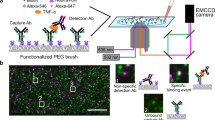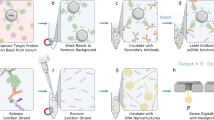Abstract
The ability to detect single protein molecules1,2 in blood could accelerate the discovery and use of more sensitive diagnostic biomarkers. To detect low-abundance proteins in blood, we captured them on microscopic beads decorated with specific antibodies and then labeled the immunocomplexes (one or zero labeled target protein molecules per bead) with an enzymatic reporter capable of generating a fluorescent product. After isolating the beads in 50-fl reaction chambers designed to hold only a single bead, we used fluorescence imaging to detect single protein molecules. Our single-molecule enzyme-linked immunosorbent assay (digital ELISA) approach detected as few as ∼10–20 enzyme-labeled complexes in 100 μl of sample (∼10−19 M) and routinely allowed detection of clinically relevant proteins in serum at concentrations (<10−15 M) much lower than conventional ELISA3,4,5. Digital ELISA detected prostate-specific antigen (PSA) in sera from patients who had undergone radical prostatectomy at concentrations as low as 14 fg/ml (0.4 fM).
This is a preview of subscription content, access via your institution
Access options
Subscribe to this journal
Receive 12 print issues and online access
$209.00 per year
only $17.42 per issue
Buy this article
- Purchase on Springer Link
- Instant access to full article PDF
Prices may be subject to local taxes which are calculated during checkout




Similar content being viewed by others
References
Tessler, L.A., Reifenberger, J.G. & Mitra, R.D. Protein quantification in complex mixtures by solid phase single-molecule counting. Anal. Chem. 81, 7141–7148 (2009).
Todd, J. et al. Ultrasensitive flow-based immunoassays using single-molecule counting. Clin. Chem. 53, 1990–1995 (2007).
Gosling, J.P.A. Decade of development in immunoassay methodology. Clin. Chem. 36, 1408–1427 (1990).
Wild, D. The Immunoassay Handbook 3rd Edn. (Elsevier, 2005).
Zhang, H.Q., Zhao, Q., Li, X.F. & Le, X.C. Ultrasensitive assays for proteins. Analyst (Lond.) 132, 724–737 (2007).
Giljohann, D.A. & Mirkin, C.A. Drivers of biodiagnostic development. Nature 462, 461–464 (2009).
Srinivas, P.R., Kramer, B.S. & Srivastava, S. Trends in biomarker research for cancer detection. Lancet Oncol. 2, 698–704 (2001).
Galasko, D. Biomarkers for Alzheimer's disease—clinical needs and application. J. Alzheimers Dis. 8, 339–346 (2005).
de Jong, D., Kremer, B.P.H., Olde Rikkert, M.G.M. & Verbeek, M.M. Current state and future directions of neurochemical biomarkers for Alzheimer's disease. Clin. Chem. Lab. Med. 45, 1421–1434 (2007).
Barletta, J.M., Edelman, D.C. & Constantine, N.T. Lowering the detection limits of HIV-1 viral load using real-time immuno-PCR for HIV-1 p24 antigen. Am. J. Clin. Pathol. 122, 20–27 (2004).
Adler, M., Wacker, R. & Niemeyer, C.M. Sensitivity by combination: immuno-PCR and related technologies. Analyst (Lond.) 133, 702–718 (2008).
Nam, J.M., Thaxton, C.S. & Mirkin, C.A. Nanoparticle-based bio-bar codes for the ultrasensitive detection of proteins. Science 301, 1884–1886 (2003).
Armani, A.M., Kulkarni, R.P., Fraser, S.E., Flagan, R.C. & Vahala, K.J. Label-free, single-molecule detection with optical microcavities. Science 317, 783–787 (2007).
Cui, Y., Wei, Q.Q., Park, H.K. & Lieber, C.M. Nanowire nanosensors for highly sensitive and selective detection of biological and chemical species. Science 293, 1289–1292 (2001).
Gaster, R.S. et al. Matrix-insensitive protein assays push the limits of biosensors in medicine. Nat. Med. 15, 1327–1332 (2009).
Fan, R. et al. Integrated barcode chips for rapid, multiplexed analysis of proteins in microliter quantities of blood. Nat. Biotechnol. 26, 1373–1378 (2008).
Thaxton, C.S. et al. Nanoparticle-based bio-barcode assay redefines “undetectable” PSA and biochemical recurrence after radical prostatectomy. Proc. Natl. Acad. Sci. USA 106, 18437–18442 (2009).
Bao, Y.P. et al. Detection of protein analytes via nanoparticle-based bio bar code technology. Anal. Chem. 78, 2055–2059 (2006).
Anderson, N.L. & Anderson, N.G. The human plasma proteome: history, character, and diagnostic prospects. Mol. Cell. Proteomics 1, 845–867 (2002).
Gorris, H.H., Rissin, D.M. & Walt, D.R. Stochastic inhibitor release and binding from single-enzyme molecules. Proc. Natl. Acad. Sci. USA 104, 17680–17685 (2007).
Rissin, D.M., Gorris, H.H. & Walt, D.R. Distinct and long-lived activity states of single enzyme molecules. J. Am. Chem. Soc. 130, 5349–5353 (2008).
Rissin, D.M. & Walt, D.R. Digital readout of target binding with attomole detection limits via enzyme amplification in femtoliter arrays. J. Am. Chem. Soc. 128, 6286–6287 (2006).
Rissin, D.M. & Walt, D.R. Digital concentration readout of single enzyme molecules using femtoliter arrays and Poisson statistics. Nano Lett. 6, 520–523 (2006).
Tan, W. & Yeung, E.S. Monitoring the reactions of single enzyme molecules and single metal ions. Anal. Chem. 69, 4242–4248 (1997).
Rissin, D.M. & Walt, D.R. Duplexed sandwich immunoassays on a fiber-optic microarray. Anal. Chim. Acta 564, 34–39 (2006).
Ferguson, R., Yu, H., Kalyvas, M., Zammit, S. & Diamandis, E. Ultrasensitive detection of prostate-specific antigen by a time-resolved immunofluorometric assay and the Immulite immunochemiluminescent third-generation assay: potential applications in prostate and breast cancers. Clin. Chem. 42, 675–684 (1996).
Jackson, T.M. & Ekins, R.P. Theoretical limitations on immunoassay sensitivity. Current practice and potential advantages of fluorescent Eu3+ chelates as non-radioisotopic tracers. J. Immunol. Methods 87, 13–20 (1986).
Bock, J.L. & Klee, G.G. How sensitive is a prostate-specific antigen measurement? How sensitive does it need to be? Arch. Pathol. Lab. Med. 128, 341–343 (2004).
Trock, B.J. et al. Prostate cancer-specific survival following salvage radiotherapy vs observation in men with biochemical recurrence after radical prostatectomy. Jama-Journal of the American Medical Association 299, 2760–2769 (2008).
Pantano, P. & Walt, D.R. Ordered nanowell arrays. Chem. Mater. 8, 2832–2835 (1996).
Acknowledgements
The project described was supported by Award Number R43CA133987 from the National Cancer Institute.
Author information
Authors and Affiliations
Contributions
D.M.R., C.W.K., D.R.F., D.R.W. and D.C.D. conceived the approach. D.R.F. built the imaging system. D.M.R., C.W.K., T.G.C., S.C.H., L.S., P.P.P., A.J.R., E.P.F., J.D.R. and G.K.P. conducted the experiments. T.P. wrote the image analysis software. L.C. prepared reagents. D.M.R. and D.C.D. wrote the manuscript. All authors were involved in designing experiments, reviewing and discussing data, and commenting on the manuscript.
Corresponding author
Ethics declarations
Competing interests
All authors are employees or advisors of Quanterix Corporation who have a minority ownership or ownership option position in the company.
Supplementary information
Supplementary Text and Figures
Supplementary Tables 1–3, Supplementary Figs. 1–3 and Supplementary Methods (PDF 250 kb)
Rights and permissions
About this article
Cite this article
Rissin, D., Kan, C., Campbell, T. et al. Single-molecule enzyme-linked immunosorbent assay detects serum proteins at subfemtomolar concentrations. Nat Biotechnol 28, 595–599 (2010). https://doi.org/10.1038/nbt.1641
Received:
Accepted:
Published:
Issue Date:
DOI: https://doi.org/10.1038/nbt.1641
This article is cited by
-
Engineered serum markers for non-invasive monitoring of gene expression in the brain
Nature Biotechnology (2024)
-
Plasma neurofilament light as a promising biomarker in neuronal intranuclear inclusion disease
Journal of Neurology (2024)
-
Comparison of CSF and plasma NfL and pNfH for Alzheimer’s disease diagnosis: a memory clinic study
Journal of Neurology (2024)
-
The role of plasma neurofilament light chain and glial fibrillary acidic protein in subjective cognitive decline and mild cognitive impairment
Neurological Sciences (2024)
-
Magnetic transferrin nanoparticles (MTNs) assay as a novel isolation approach for exosomal biomarkers in neurological diseases
Biomaterials Research (2023)



